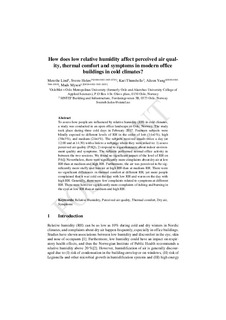| dc.contributor.author | Lind, Merethe | |
| dc.contributor.author | Holøs, Sverre Bjørn | |
| dc.contributor.author | Thunshelle, Kari | |
| dc.contributor.author | Yang, Aileen | |
| dc.contributor.author | Mysen, Mads | |
| dc.date.accessioned | 2020-02-04T11:12:36Z | |
| dc.date.available | 2020-02-04T11:12:36Z | |
| dc.date.created | 2018-11-14T12:20:39Z | |
| dc.date.issued | 2019 | |
| dc.identifier.isbn | 978-3-030-00662-4 | |
| dc.identifier.uri | http://hdl.handle.net/11250/2639520 | |
| dc.description.abstract | To assess how people are influenced by relative humidity (RH) in cold climates, a study was conducted in an open office landscape in Oslo, Norway. The study took place during three cold days in February 2017. Fourteen subjects were blindly exposed to different levels of RH in the order of low (14±1%), high (38±3%), and medium (24±4%). The subjects received emails twice a day (at 12:00 and at 14:30) with a link to a webpage where they were asked to: 1) assess perceived air quality (PAQ), 2) respond to a questionnaire about indoor environ-ment quality and symptoms. The subjects performed normal office activity in between the two sessions. We found no significant impact of the level of RH on PAQ. Nevertheless, there were significantly more complaints about dry air at low RH than at medium and high RH. Furthermore, the air was perceived to be sig-nificantly more stuffy and heavier at high RH than at medium RH. There were no significant differences in thermal comfort at different RH, yet more people complained that it was cold on the day with low RH and warm on the day with high RH. Generally, there were few complaints related to symptoms at different RH. There were however significantly more complaints of itching and burning in the eyes at low RH than at medium and high RH. | nb_NO |
| dc.language.iso | eng | nb_NO |
| dc.relation.ispartof | Cold Climate HVAC 2018 - Sustainable Buildings in Cold Climates | |
| dc.subject | Relative Humidity | nb_NO |
| dc.subject | Perceived air quality | nb_NO |
| dc.subject | Thermal comfort | nb_NO |
| dc.subject | Dry air | nb_NO |
| dc.subject | Symptoms | nb_NO |
| dc.title | How Does Low Relative Humidity Affect Perceived Air Quality, Thermal Comfort and Symptoms in Modern Office Buildings in Cold Climates? | nb_NO |
| dc.type | Chapter | nb_NO |
| dc.description.version | acceptedVersion | nb_NO |
| dc.rights.holder | This is a pre-print of a contribution published in Cold Climate HVAC 2018 in Johansson D., Bagge H., Wahlström Å. (eds) published by Springer. The final authenticated version is available online at: https://doi.org/10.1007/978-3-030-00662-4_76 | |
| dc.subject.nsi | VDP::Teknologi: 500 | nb_NO |
| dc.source.pagenumber | 899-909 | nb_NO |
| dc.identifier.doi | 10.1007/978-3-030-00662-4_76 | |
| dc.identifier.cristin | 1630427 | |
| cristin.unitcode | 7401,30,20,0 | |
| cristin.unitname | Bygninger og installasjoner | |
| cristin.ispublished | true | |
| cristin.fulltext | postprint | |
| cristin.qualitycode | 1 | |
